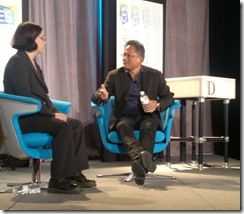 Jen-Hsun Huang, the CEO of Nvidia has recently announced a major Tegra 2 win (Honeycomb) and a new project “extending the performance range of the ARM instruction-set architecture, enabling the ARM architecture to cover a larger portion of the computing space inch so it’s no surprise that the CEO is positive when he talks about ARM.
Jen-Hsun Huang, the CEO of Nvidia has recently announced a major Tegra 2 win (Honeycomb) and a new project “extending the performance range of the ARM instruction-set architecture, enabling the ARM architecture to cover a larger portion of the computing space inch so it’s no surprise that the CEO is positive when he talks about ARM.
I had the chance to watch him being interviewed by All Things D mobile correspondent Ina Fried last week at CES and with Galaxy Tab in hand I was put to the test in noting quote after quote of amazing pro-ARM comments from Jen-Hsun. How about some of these gems:
“2011 is likely to go down like 1995. We will realise that the personal computing industry was redefined inch. Jen-Hsun is referring to Windows 95, the operating system that changed the way consumers interacted with personal computers.
“The most important architecture going forward is likely to be ARM. inch
“Whatever expectation you have…are going to be fully met by mobile computing devices within the next 3 to 4 years. inch
“3D on phone is a foregone conclusion. This piece of glass is is likely the most accommodating piece of glass for 3D inch
Here’s a quick video I did of Jen-Hsun demonstrating the LG Optimus 2X. There’s a fuller video over at All Things D
In addition to Tegra 2, 3D and Honeycomb announcements, Nvidia have also taken a Cortex A15 license and have announced project Denver which appears to be looking to combine future ARM architecture (possibly Cortex A15, possibly a new license for ARMv7 or even ARMv8!) and running parallel with the Windows on ARM project. If Nvidia are chosen as the reference design for that, they are sitting pretty! An Nvidia blog post gives more info about Denver.
However, Nvidia talks about ARM like it’s the only low-power choice but we know that Intel are moving into this space too. In fact, as processing power requirements reach into the same 1W envelope, it’s the screens, radios, batteries and software need to be sorted out. An wild, uncontrolled third party app can negate a lot of potential hardware efficiencies. Also, if Windows 8 is supporting ARM, I expected it to also be supporting the new power features of the Intel platforms that bring it right alongside ARM. Don’t forget that Android is running on Intel too!
Nvidia appear to have an excellent leader, strategist and spokesperson in Jen-Hsun and it’s unlike any other company playing in this mobile game. The brand is looking good, products are looking good, strategy and partnerships are going well and given one or two more major wins, Nvidia will rise to the top very quickly.
Thanks to Ina Fried for (literally) last-minute access to All Things D at CES. Ina runs the Mobilized blog for All Things D and is on Twitter here.











Getting Microsoft to port Windows to ARM is a huge coup for ARM. The biggest challenge now is how to get existing applications running on this new platform. Will Microsoft update Visual Studio to compile natively for ARM or will all 3rd party apps be .NET?
I think that Windows 8 will still run primarily on x86-based systems due to the compatibility problems.
I tend to agree. It’s a 5th year project to get everything duplicated. Imagine the driver issues!